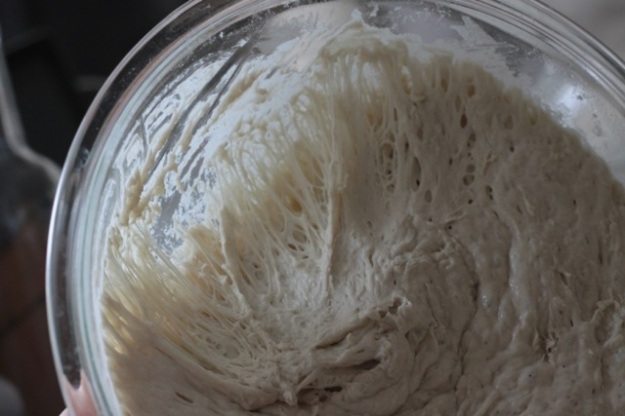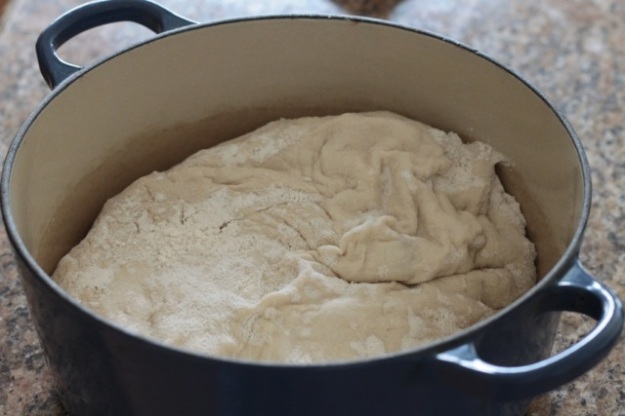First, the ingredients:
– 3 cups of flour (all-purpose or bread. I prefer to use bread flour, for higher gluten content)
– 1 1/4 tsp salt
– 1/4 tsp yeast
– 1 5/8 cup room temp water (the water doesn’t need to be as warm as it usually needs to be for bread, since this dough will sit for 18 hours on the counter).
Directions:
1. Mix the dry ingredients in a large bowl. Then add the water and mix it all up with a spatula or wooden spoon. I would usually use a kitchen aid for making bread, but not for this. It’s way too simple to justify washing the kitchen aid after. Just mix until the ingredients are well incorporated. It would be smooth. That’s fine, though. Now cover with plastic wrap and wait 18 hours. The original recipe says 12-18, but I really think 18 is best for full gluten development. After 18 hours, it looks like this. Kind of bubbly. 
 2. Put some flour on your countertop and remove dough from the bowl onto the floured surface. I have to use a spatula to get the dough out of the bowl. It’s a sticky mess otherwise. Cover with the plastic wrap and allow to rest 10-15 minutes.
2. Put some flour on your countertop and remove dough from the bowl onto the floured surface. I have to use a spatula to get the dough out of the bowl. It’s a sticky mess otherwise. Cover with the plastic wrap and allow to rest 10-15 minutes.  3. Now put plenty of flour (original recipe says cornmeal or flour. I prefer to use flour) on a clean kitchen towel and transfer the bread onto it.
3. Now put plenty of flour (original recipe says cornmeal or flour. I prefer to use flour) on a clean kitchen towel and transfer the bread onto it.  Sprinkle more flour on top of dough and cover with the kitchen towel. Let it rise for another 2 hours.
Sprinkle more flour on top of dough and cover with the kitchen towel. Let it rise for another 2 hours.  4. At least 30 minutes before the 2 hour rise is finished, put a cast iron dutch oven in your oven and preheat to 450 degrees F. The cast iron needs to be really hot to get a nice crust on your bread. When it’s time, carefully remove the dutch oven and gently flop the dough in. Quickly put the lid back on and put it back in the oven. (And don’t forget, the handle on the lid is very VERY hot!! I have made this mistake before and it wasn’t pretty. I suggest leaving your hot pad on the lid so you don’t forget).
4. At least 30 minutes before the 2 hour rise is finished, put a cast iron dutch oven in your oven and preheat to 450 degrees F. The cast iron needs to be really hot to get a nice crust on your bread. When it’s time, carefully remove the dutch oven and gently flop the dough in. Quickly put the lid back on and put it back in the oven. (And don’t forget, the handle on the lid is very VERY hot!! I have made this mistake before and it wasn’t pretty. I suggest leaving your hot pad on the lid so you don’t forget). 
 5. Bake for 30 minutes with the lid on. Remove the lid and bake for another 15 minutes, until the bread is nice and golden. Place on cooling racks and try to hold yourself back from cutting into it right away. Maybe go out and get yourself some nice cheese to eat with the bread. Or olive oil. Or pesto. Really, there are many good options here. Enjoy!
5. Bake for 30 minutes with the lid on. Remove the lid and bake for another 15 minutes, until the bread is nice and golden. Place on cooling racks and try to hold yourself back from cutting into it right away. Maybe go out and get yourself some nice cheese to eat with the bread. Or olive oil. Or pesto. Really, there are many good options here. Enjoy! 




